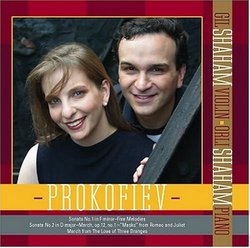| All Artists: Gil Shaham, Orli Shaham Title: Sergei Prokofiev: Works for Violin and Piano Members Wishing: 2 Total Copies: 0 Label: Artemis Classics Release Date: 9/21/2004 Genre: Classical Styles: Opera & Classical Vocal, Ballets & Dances, Ballets, Chamber Music, Historical Periods, Classical (c.1770-1830), Modern, 20th, & 21st Century, Instruments, Keyboard, Strings Number of Discs: 1 SwapaCD Credits: 1 UPC: 699675155520 |
Search - Gil Shaham, Orli Shaham :: Sergei Prokofiev: Works for Violin and Piano
 | Gil Shaham, Orli Shaham Sergei Prokofiev: Works for Violin and Piano Genre: Classical
|
Larger Image |
CD DetailsSimilar CDs |
CD ReviewsDEPENDABLE DAVID BRYSON | Glossop Derbyshire England | 07/15/2007 (5 out of 5 stars) "Prokofiev seems to have been rather shy of composing for the violin. Of the six works presented here only one, the F minor sonata, was intended for the violin in the first place, and it needed persuasion from David Oistrakh to make the composer rescue it from his `postponed' file. The other sonata was originally for flute and piano, the Five Pieces op 35 started life as wordless vocalises, and the other three short numbers are arrangements by Heifetz. However the refitting jobs have been done well, and the pieces all sound natural as we have them here, but I am tantalised by the revelation in the liner-note that the F minor sonata was inspired by Handel. Its 4-movement scheme suggests the slow-quick-slow-quick layout of Handel's duo sonatas whereas the 4 movements of the other sonata are to the later pattern standardised by Haydn in his quartets and symphonies, but I'm still groping for what the precise influence of Handel might have been on the work's content. This set of performances ought to be a safe bet for anyone who likes Prokofiev at all, but particularly for those who find the accounts by Kremer and Argerich over-characterised. I am not myself of their number. I still prefer the dramatic handling that Kremer and Argerich give to the two sonatas, especially to the first, and I'm also pleased with the more resonant and roomy acoustic on the DG disc. Nevertheless I find more or less nothing to criticise here, so when I also take into account the three small bonus extras here I can think of no good reason for withholding a fifth star. Gil and Orli Shaham take each movement of the eight that make up the sonatas just a tad slower than Kremer and Argerich do, but as if by way of counterbalance they play the last four of the Five Pieces a little faster. The playing is accomplished and idiomatic, and brother and sister make a smooth and sympathetic partnership. The famous ghostly 'freddo' effect for the violin in the first movement of the first sonata is very effectively done indeed, the lyricism of the second sonata is most attractively put over, there is plenty of verve in the `Heifetz' numbers, the Five Melodies are properly appealing - as I've said once already, everything is as it should be. This is a textbook set of model performances, and the recording is a model of tact and discretion to match. I found the lengthy liner-note by Harlow Robinson very interesting and informative, but perhaps I ought to say that it is by way of being something of an essay going beyond basic comment on the works comprised in the set." Both Shahams are enticing musicians Santa Fe Listener | Santa Fe, NM USA | 12/01/2006 (4 out of 5 stars) "
Gil Shaham has always held a youthful appeal, not to the extent of Nigel Kennedy's punk-rock pose (which has earned him million-seller CDs), but enough to support unusual ventures. His Paganini duets with guitar sold well, and he took it on tour. Now he has an independent label to promote his music-making with his talented sister, pianist Orli. I've enoucntered a CD devoted to Faure as well as this one devoted to Prokofiev's two violin sonatas. Many listeners may lie the side attractions more--we get transcriptions of the March form the Love for Three Oranges as well as lyrical Songs Without Words. As to the sonatas themselves, brother and sister make a very good team. Orli is expressive and secure. She's not the world-class player that gil is, however. His execution of both sonatas is first-rate, the equal of Perlman in the more lyrical, tuneful Sonata No 2, where Shaham's trademark sweetness of tone is very enticing. The aggresive Sonata No. 1 calls for the bite of Oistrakh-Richter or the toughness of Kremer-Argerich, so it's not as effective. but the Shahams cretainly give a very good reading. Overall, this is a highly successful disc on all counts." |

 Track Listings (16) - Disc #1
Track Listings (16) - Disc #1